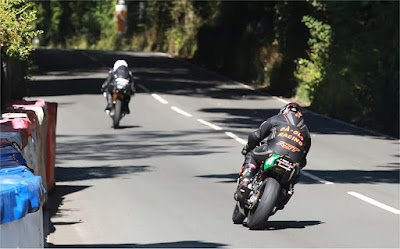Even professional drivers were put off by its twitchiness when pushed to the limit. But that didn’t stop this quirky Porsche taking-on the big boys. And winning. In Europe, 914s came home first in their class and took overall victory numerous times, and repeated the feat in the US. 914s were driven to at least 41 class wins, in addition to a minimum of 71 podium positions. They’re still winning, with 914s regularly used across the US and Europe to this day.
 |
| The 'original' 914 |
Cast your mind back to 2016, and you may recall the release of Roy Smith’s Porsche: The Racing 914s. This comprehensive study of the motorsport exploits of the 'funny little car' created as an entry-level Porsche proved much more popular than we ever imagined, gaining a place in BookAuthority's Best Car Racing Books of All Time. Originally a hardback limited to 1500 copies, we've decided to bring this great book back to the bookshelf in paperback format.
If you're not familiar with the 914's origins, or Roy's book, you'd do well to take a look at our 2017 interview with Roy – watch it on the book page over on our website, or here …
As chance would have it, and whilst working on the new edition, we received a message from a customer, Tolo Palmer, enquiring if the book was being reprinted. Nothing too unusual there; we get such enquiries all the time. What is unusual, though, is that Tolo’s friend owns a couple of 914s, including one in Roy's book.
 |
| Tolo (centre), and Dominik (right) with co-driver Gerd Ottenburger in 2015, after his fifth win in Mallorca. |
We simply couldn’t resist sharing some of Tolo's story. Over to you, Tolo …
I grew up in Mallorca, and one day in 2003, being 11 years old and a little ill, my mother took me to see the doctor, followed with a visit to a local town bakery. While taking my medicine, I started to feel the ground shake and hear a loud noise. But it wasn’t the medicine: I turned my head to see a beautiful, original, orange Porsche 914/6 GT. I immediately ran behind the car, which stopped to turn at the next junction, and saw a line full of stunning classic cars behind it – a 911ST driven by Walter Röhrl, and a 911SR driven by Jürgen Barth, to name just two.
I was so excited that as soon as I got home I told dad what had happened. He told me that there was a Classic rally going on, and that we could go and see it on Saturday. The day came, and we went to the race track, spending the whole day there. Ever since then, I’ve been a classic car lover.
The rally was held again the following year, so I went to see some of the stages. Sliding around the track, and smoothly driven – and driven hard – was an orange 914/6 GT, similar to the one I saw last year. On the last day of the rally, again at the track, the orange 914, driven by Dominik, took the overall win in the Trofeo Baleares Clasico, part of the European Rally Championship.
I had a photo taken of me leaning on the car (right), and hoped to see it again the following year. Sadly, that didn’t happen, but in 2008 Dominik returned to Mallorca with a beautiful 911 3.0 RS. Being just a teenager, my English was pretty poor, but I was very curious and went over to Dominik to ask for his autograph, which he supplied with pleasure.
On the second day of the Rally, Dominik saw me in the service area and came over to chat. I was very shy but couldn’t resist asking him if he still had the orange beauty that won in 2004. That put a big smile on is face, and after an interesting conversation he offered for me to spend the final day of the Rally with his service crew at the track.
On that day, I took the photo of me and the 914 to show Dominik and the crew: they loved it. Better still, Dominik won the Rally, and jumping out of his 911 afterwards, handed me his gloves as a memento. I put them on and sat in the car in tears of joy! Our good friendship has grown ever since. In 2009 he brought me a set of his first race overalls as a memento, and won the Rally Mallorca once again.
Going back to the 914, I went to Germany for a few years, where a 914 replica was being worked on. Dominik said that when the car was ready (it was finished in 2014), he was going to use it at the Eifel Rallye Festival – so, of course, I went. Dominik had owned an original 914 since 1999, but it sat idle in Dominik's workshop until 2015, when it was raced for the last time at the AvD Histo-Monte Rally – and won!
In 2022, for my 30th birthday, Dominik took me on a rally stage in the 914. I have quite a lot of experience around cars, but this all new to me; I couldn’t even put my seatbelt on. All I can say is that before we crossed the finish line, I was in tears. So many emotions came together for me, a mix of nostalgia and, I think, love. But that car is very special; as special as my friend Dominik. And that’s how I came to befriend a very special 914 and its very special driver.
Now, that’s a story all us petrolheads can relate to. Dominik’s original 914 was special for a number of reasons, not least of which being its appearance in Roy's book. But his replica is equally special. Following his 2015 win, and after being offered a lot of money for the car, Dominik had something of an epiphany. It dawned on him that, should he total the 914, he wouldn’t simply be destroying any old car, he would be destroying a very important piece of Porsche history.
 |
| The replica 914, Mallorca 2014 |
Dominik decided to make a clone of his original 914, which he still owns, but is now retired from competition. So began a journey of discovery, as Dominik built-up a 914 road car shell into a machine suitable for the rallying circuit. Originally, the replica was intended to be a straight copy, but studying the FIA's historic racing regulations, he soon realised that there were many areas of the car that could be changed without falling foul of the rules.
The build that followed involved a deep-dive into the nitty gritty details. The end result? A car with 250 shorter, lighter or smaller replacement components, and a 140Kg weight saving over the original car – an 800Kg rally rocket. The car has even been catalogued as 'the best rally Porsche 914 ever made.' The work Dominik undertook, and the racing exploits of this 914, deserve a book of their own; we don't have that, but, fortunately, in 2018 Petrolicious penned this great piece on the 914: take a look here.
We’d like to thank Tolo for sharing his photos, his story of friendship and two very special 914s. We wish Tolo, Dominik, and, of course, the orange 914 many long and happy races in the future!
Hi-ho Silver!
It'll come as no surprise to hear that Roy has a 914 of his own, it is his second 914 and its a tad special. Incredibly, the paperwork trail verifies nearly every year of its life – not something many classics can boast. And this is no ordinary example. The car left the factory almost exactly 53 years ago – the 12th October 1970. The 13th car produced that day, this was a special order, specced with black paint, tinted windows, 1.7-litre 4-cylinder engine, and sporting factory Minilites, pus a rarely requested limited-slip diff option.
The car was ordered by an American Porsche-loving couple. They wanted a car to run in motorsports events across the US, and ended up winning several Porsche Club of America awards. It was later sold to another couple who continued to compete with the car. They even took it to Italy, while the husband was stationed with the US military there, before returning to the USA in the 1980s.
Brought to the UK in 1990 by non-other than Henry Pearman, of Eagle fame (you really must check out his collection), it was sold by the Lenham Motor company, Kent, to its first UK owner, whose partial restoration included changing the colour to silver. In 1994 it was acquired by a 914 fan and made several appearances in magazines during his 25 year ownership, before it was acquired by Roy in early 2020.
Roy commissioned Greatworth Classics near Banbury, to install a fresh, period 6-cylinder Porsche 2.7-litre engine, with high compression heads, polished ports and a reprofiled cam, fully balanced, its 5-speed 'box retaining the limited slip diff. Body and chassis are original, apart from the usual work needed to keep a 53 year old car in perfect condition, and now of course has uprated suspension, and brakes.
So, there is the tale of some very special 914s. You can discover even more of the 914's racing exploits and successes in Roy Smith’s Porsche: The Racing 914s, reprinting in paperback format, and available in the UK early next year. Keep your eyes on our social channels for more details closer to publication, or head over to our store and pop your email in the Notify Me field to get an email when the book is available to buy.
Porsche
The Racing 914s
Roy Smith
The remarkable little car that turned into a big hearted racer. A study in pictures, statistics, factory information, and interviews, that show the Porsche 914 in a whole new light.
£40 UK 🇬🇧 $65 USA 🇺🇸 $78 CAN 🇨🇦
V5934 • Paperback • 22.5x22.5cm • 320 pages • 452 pictures
ISBN: 978-1-787119-34-5 • UPC: 6-36847-01934-1
If you’ve an interesting story to tell us, get in touch by email, or send a message on social; we’d love to hear it.

































